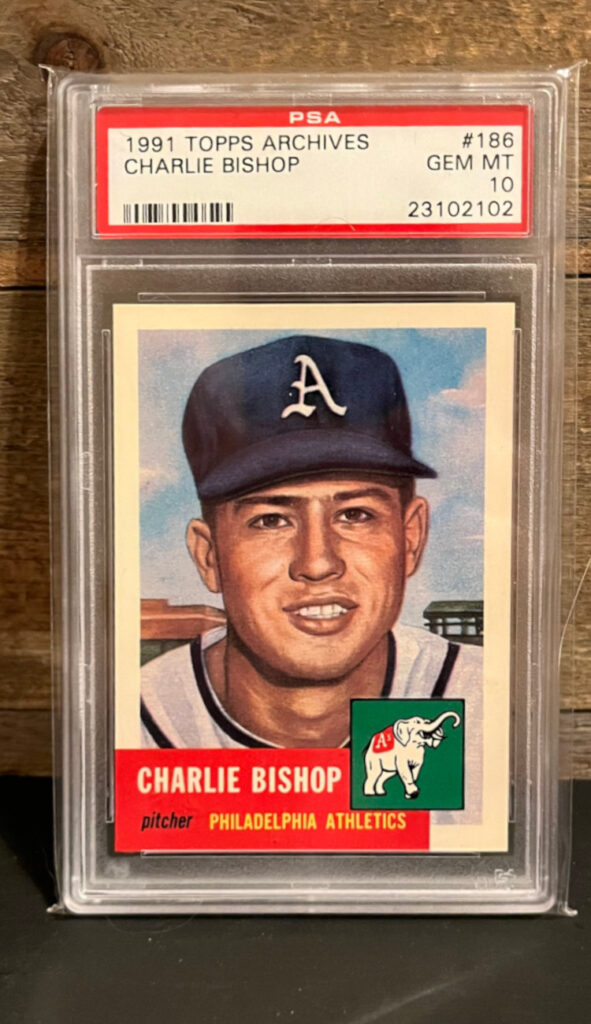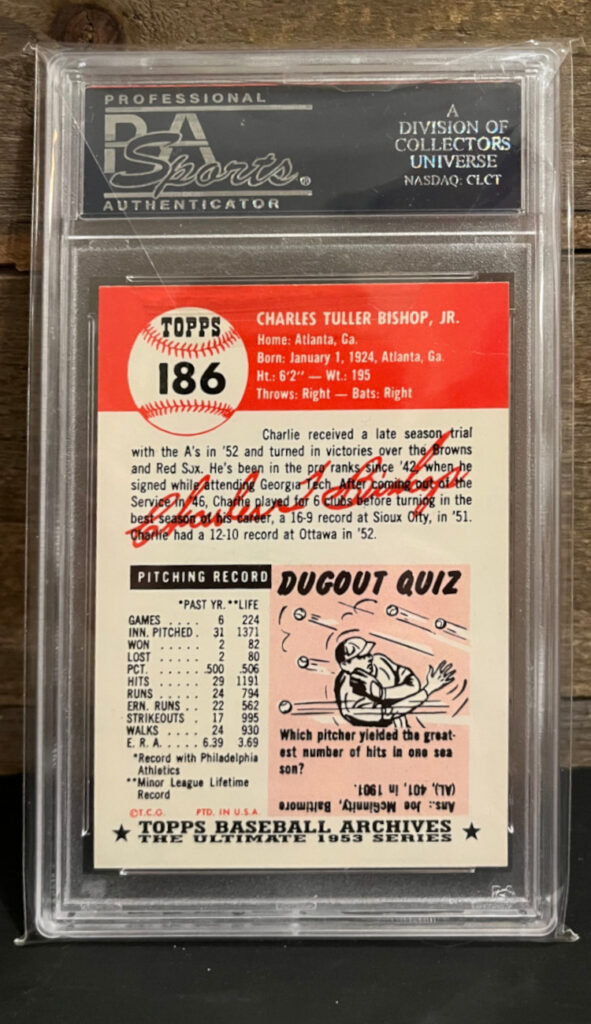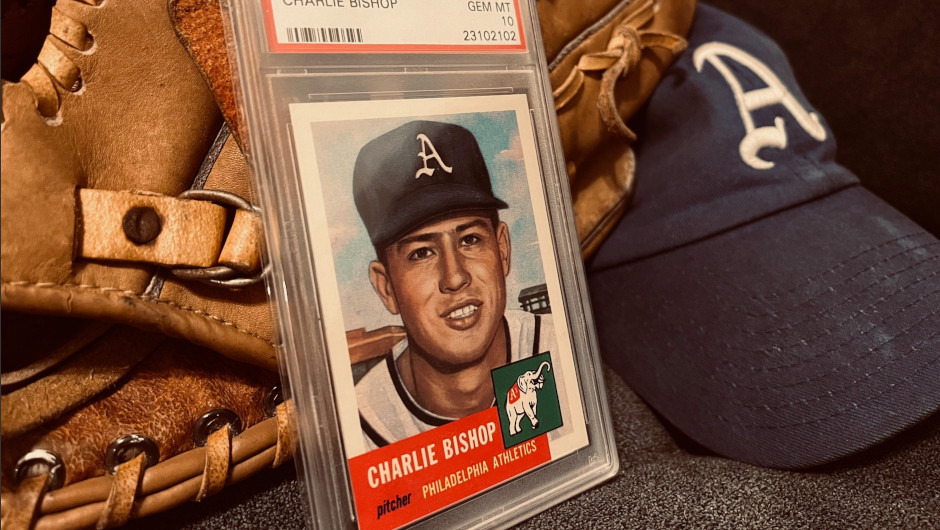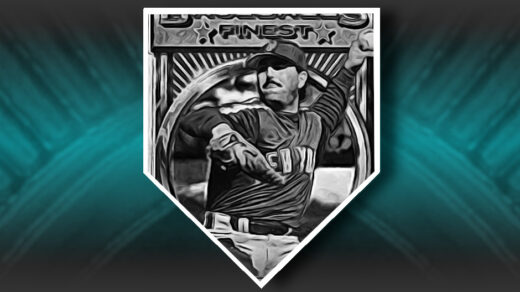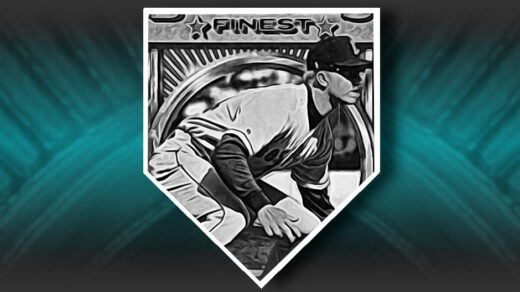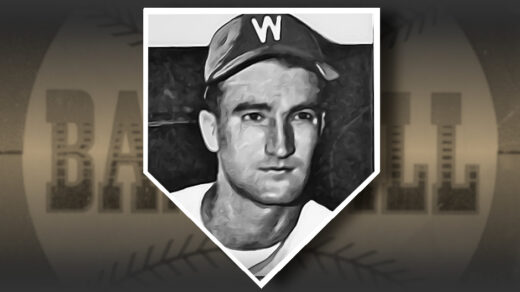I was a baseball nut as a kid. I say this not to imply I ever stopped liking the game, but to make clear that my infatuation with the sport and its trading cards was a defining characteristic for anyone who met 8-year-old me.
One day in late 1991 my brother and I received an envelope from one of our aunts. Inside was a pair of identical autographed baseball cards and a note. The cards were gifts and the note explained that the player they depicted was a family member who had heard we were big baseball fans. This was news to us. We were related to a professional baseball player? Awesome! That left just one question: Who was this guy?
The player in question was a former Philadelphia Athletics pitcher named Charlie Bishop. A quick glance at the statistical table on the back revealed one year of MLB service consisting of 6 appearances on the mound. These did not go particularly well, as he gave up 22 runs in 31 innings of work (6.39 ERA). This was, however, an early 1950s Athletics team and us pint-sized optimists had to commend the ability to generate a .500 winning percentage with that club. A much larger body of minor league work was represented in his career totals. This included a lifetime ERA of 3.69, so there was room to hope.
After we established that he had not had a lights out rookie season, we wondered exactly how we were related. After a series of inquiries to various relatives I pieced together that we were not truly blood relatives. The aunt through which the connection came married into my family and Mr. Bishop himself married into her family. That’s an extremely tenuous connection but it was close enough for a couple of Little League baseball players to claim a family pedigree when on the field with our teammates. Welcome to the family Charlie.
So, am I genetically related to a baseball player? No, not anymore so than I am to a randomly chosen player at whatever ballgame I next attend. Will that put a stop to a quest that began 30 years ago to find all of his baseball cards? Absolutely not.
Looking at the Archives
The cards that arrived in the envelope from my aunt caused quite the commotion for my brother and I. For starters, the oldest card I had in my collection at the time was a 1975 Topps Willie Stargell. The newly arrived Topps card referenced the 1952 season. I knew from scanning the images at the top of each set listed in Beckett price guides that this was not from the famous ’52 set and quickly surmised that this was from Topps’ colorful 1953 issue. The card was in fantastic condition, something I had never seen before in a card of its age.
A few months later it dawned on me that I was mistaken. The card was not from 1953, but rather a reprint of the ’53 issue. In 1991 Topps issued a reproduction of most of its 1953 set along with 57 imaginary cards that were not part of the original release. They were billed as “Topps Baseball Archives,” a series that would see a few additional iterations as time went on and become known in collecting circles simply as “Topps Archives.”
These cards were the same size of modern 2 1/2 x 3 1/2 cardboard, not the larger 2 5/8 x 3 3/4 size of the early 1950s. Unlike the originals, cards are covered in a high level of gloss on both sides akin to 1991’s Stadium Club release. In fact, wax boxes of Archives cards use a large, bold font to announce the cards use “Stadium Club photo imaging technology” in their production. White borders surrounding most of the photos are wider relative to the originals, a function of the reduced size of the cards slightly throwing off the dimensions of the originals.
Card backs revealed more differences. Archives were printed on bright white card stock while cards issued in 1953 were produced using the grayish cardboard so familiar to vintage collectors. The white cardstock produces more vivid hues in areas covered by red ink. Two lines of text and a pair of stars round out the contrasts at the bottom of the card, identifying the cards as part of “Topps Baseball Archives, The Ultimate 1953 Series.”
The heavy gloss did not react very well with the rollerball pen with which my card had been autographed. The result was something like an signature-shaped embossed design with regularly spaced drops of congealed ink rather than a legible autograph.
How the Card Got From Topps to Charlie (and Later Us)
Shortly after receiving this card, a thought occurred to my brother and I. How did he manage to get two identical cards of himself in such nice condition? Was he combing card shows looking for them? Was he in the habit of breaking down mountains of unopened boxes? Was he in tune enough with the hobby to even know that Topps was reprinting a set in which he had a fleeting appearance?
A quick phone call to my aunt revealed the answer: Topps gave him the cards directly. We were told Topps sent all the players in the set a “big stack of cards.” When pressed for a number she said it was something like 50-100 copies. While my memories of the time are very faded, I am fairly certain she made up a plausible number to satisfy the curiosity of her nephews.
While the exact quantity of cards will likely be forever unknown, it was interesting to learn that Topps was giving away stacks of player-specific cards as part of the compensation process for licensing individuals’ publicity rights for the set. The 38 years that had elapsed since the original 1953 release had also wiped away the very temporary permissions granted by the company’s contracts with players. Following a playbook developed for the 1983 release of Topps’ 1952 reprint collector set, the firm set to work contacting those that were to be included in the set. Compensation for signing a new contract was standardized for most players, though it should be noted that Mickey Mantle, Willie Mays, and possibly a few others received much larger checks. A Chicago Tribune article appeared in 1991 reported that the vast majority of players were offered a flat $500 for their participation with all but one coming to terms with Topps.
Charlie Bishop Collecting Goals
I would like to finally piece together a complete run of Charlie Bishop cards. It is a fairly short list but carries with it some really obscure regional issues that provide a challenge. There are one or two that I believe theoretically exist, but interest in the cards is so low that complete checklists of these sets may never have been compiled. Excluded from my goals are “cards” that were produced from cut signatures in the last few years as well as newspaper photo cuttings that are sometimes advertised as a form of quasi-baseball card. I have previously assembled most of the known checklist with low grade examples and am now trying to tackle this project in high grade.
My autographed card is no longer in my possession as I liquidated my original collection when I paused my hobby and needed to pay for tuition. However, I did manage to find a replacement Archives card to start off this new corner of my collection. I have no idea why anyone would have sent this card off to PSA but am glad they did.
